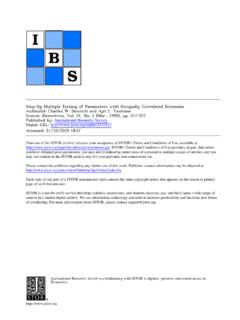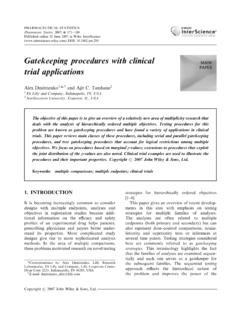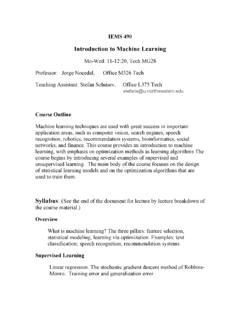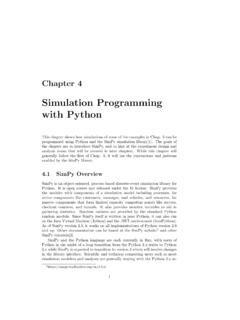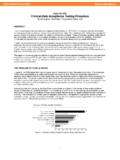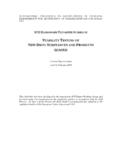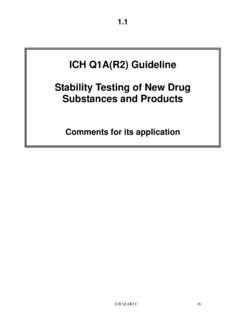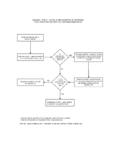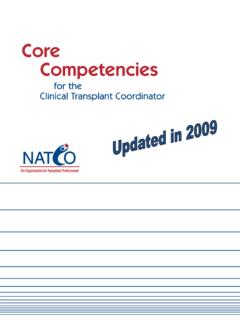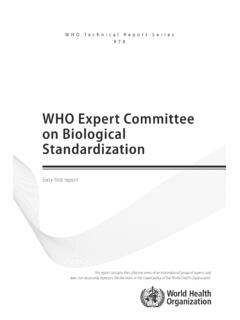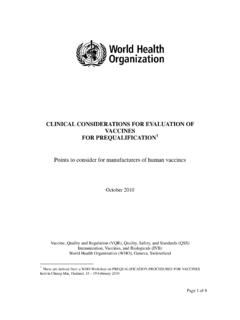Transcription of A Step-Up Multiple Test Procedure - Northwestern University
1 A Step-Up Multiple Test ProcedureAuthor(s): Charles W. Dunnett and Ajit C. TamhaneSource: Journal of the American Statistical Association, Vol. 87, No. 417 (Mar., 1992), pp. 162-170 Published by: American Statistical AssociationStable URL: : 21/10/2010 17:48 Your use of the JSTOR archive indicates your acceptance of JSTOR's Terms and Conditions of Use, available JSTOR's Terms and Conditions of Use provides, in part, that unlessyou have obtained prior permission, you may not download an entire issue of a journal or Multiple copies of articles, and youmay use content in the JSTOR archive only for your personal, non-commercial contact the publisher regarding any further use of this work. Publisher contact information may be obtained copy of any part of a JSTOR transmission must contain the same copyright notice that appears on the screen or printedpage of such is a not-for-profit service that helps scholars, researchers, and students discover, use, and build upon a wide range ofcontent in a trusted digital archive.
2 We use information technology and tools to increase productivity and facilitate new formsof scholarship. For more information about JSTOR, please contact Statistical Association is collaborating with JSTOR to digitize, preserve and extend access to Journalof the American Statistical Step-Up Multiple Test Procedure CHARLES W. DUNNETT and AJIT C. TAMHANE* We consider the problem of simultaneously testing k 2 2 hypotheses on parameters 01 . ok. In a typical application the O's may be a set of contrasts, for instance, a set of orthogonal contrasts among population means or a set of differences between k treatment means and a standard treatment mean. It is assumed that least squares estimators 01, .., ok are available that are jointly normally distributed with a common variance (known up to a scalar, namely the error variance ao2) and a common known correlation.
3 An independent x2-distributed unbiased estimator of a-2 is also assumed to be available. We propose a Step-Up Multiple test Procedure for this problem which tests the t statistics for the k hypotheses in order starting with the least significant one and continues as long as an acceptance occurs. (By contrast, the step -down approach, which is usually used, starts with the most significant and continues as long as a rejection occurs.) Critical constants required by this Step-Up Procedure to control the type I familywise error rate at or below a specified level a are computed for both one-sided and two-sided testing problems. Power comparisons are made for one-sided testing problems with the well-known normal theory based single- step and step -down test procedures , and also with a Step-Up test Procedure proposed for a wider class of problems by Hochberg.
4 (Two improvements over Hochberg's Procedure by Hommel and Rom provide at best marginal increases in power, with the former being also more difficult to apply, and hence they are not included here.) Two different definitions of power are considered-the probability of rejecting all false hypotheses and the probability of rejecting at least one false hypothesis; the results are found to be qualitatively similar. The proposed Step-Up Procedure is more powerful than the single- step Procedure except when only one hypothesis is false, in which case it is slightly less powerful. Similarly, it is slightly less powerful than the step -down Procedure when a few hypotheses are false, but it is more powerful when most or all hypotheses are false, and this power advantage increases with the number of such hypotheses under test.
5 The proposed Step-Up Procedure is uniformly more powerful than the Hochberg Procedure and its improvements. A disadvantage of the proposed Step-Up Procedure is the greater difficulty of computing its critical points. These are given for one-sided and two-sided tests for 5% level of significance. KEY WORDS: Comparisonwise approach; Experimentwise approach; Familywise error rate; Joint p-values; Multiple com- parison procedures ; Multivariate t distribution; Power; Single- step Procedure ; step -down Procedure . 1. INTRODUCTION The purpose of many empirical studies is to compare sev- eral treatment groups by estimating differences or by per- forming tests of significance on relevant parameters. Such Multiple comparisons in the same study are the rule rather than the exception. There has been much debate and con- troversy as to whether statistical adjustments are necessary for taking into account the multiplicity of inferences.
6 One school of thought, as advanced by Miller (1966), Scheff6 (1953), Tukey (1953), and others, is that such adjustments should be made by requiring the inference procedures to satisfy the condition that the probability of at least one wrong inference ( , at least one type I error in a Multiple hy- pothesis testing problem) is controlled at or below a spec- ified level a. This is called the "experimentwise" or the "familywise" error rate (FWE) control approach. The op- posite school of thought, as represented, for example, by Carmer and Walker (1982), Nelder and some other discus- sants of O'Neill and Wetherill (1971), O'Brien (1983), Perry (1986), and Rothman (1990), maintains that such adjust- ments are not needed and that each inference should be dealt with separately, which is referred to as the "comparison- wise" error rate control approach.
7 A third school of thought, led by Duncan [ , Duncan (1965), Waller and Duncan * Charles W. Dunnett is Professor Emeritus, Department of Mathe- matics and Statistics and the Department of Clinical Epidemiology and Biostatistics, McMaster University , Hamilton, Ontario, Canada L8S 4K1. Ajit C. Tamhane is Professor, Department of Statistics and the Depart- ment of Industrial Engineering and Management Sciences, Northwestern University , Evanston, IL 60208. Charles W. Dunnett's research was sup- ported by the Natural Sciences and Engineering Research Council of Can- ada. The authors thank Anthony J. Hayter for his help in investigating the existence of critical constants for the proposed Procedure . The authors are also grateful to the two referees for their suggestions, which greatly improved the article.]
8 (1969), Duncan and Dixon (1983)] adopts a Bayesian de- cision-theoretic approach to Multiple comparisons problems assuming prior distributions on the unknown parameters, linear loss functions for type I and type II errors for indi- vidual significance tests , and an additive loss function for the overall loss. For the pairwise comparison problem, the resulting test Procedure has the nature of a comparisonwise Procedure in the sense that the critical constant it uses does not depend on the number of comparisons (as do the critical constants used by the familywise procedures ); however, it does differ from the customary comparisonwise procedures [ , the unprotected least significant difference (LSD) test] by making this constant depend in an inverse way on the analysis of variance F statistic, which is a sample measure of the disparity between the treatment means being compared.
9 The use of the experimentwise approach is called for in the following situations: (1) when a conclusion is reached that requires the simultaneous correctness of several infer- ences and (2) when a conclusion is reached that hinges on the correctness of an inference that has been selected in light of the data. For example, consider a pharmaceutical company that compares several drugs with a standard in the same study for the purpose of determining which ones give the most improvement, with the goal of selecting one of them to recommend for further developmental work. If the drug that happens to be selected for this purpose is, in fact, inferior to the standard, then a serious error would be made. Therefore, it is necessary to control the probability of mak- ing such an error, which is achieved by using the experi- mentwise approach.
10 On the other hand, if several treat- ments are included in the same experiment solely for the ? 1992 American Statistical Association Joumal of the American Statistical Association March 1992, Vol. 87, No. 417, Theory and Methods 162 Dunnett and Tamhane: A Step-Up Multiple Test Procedure 163 purpose of economy and efficiency, and the comparisons of interest are inherently separate from each other and could logically have been examined in separate experiments were it not for the inefficiency of doing this, then the compari- sonwise approach is appropriate (O'Brien 1983). Duncan's approach offers an alternative solution to Multiple compar- isons if the underlying assumptions, particularly the one concerning the additive form of the overall loss function (which is the reason for the comparisonwise nature of the Procedure ), are satisfied.
